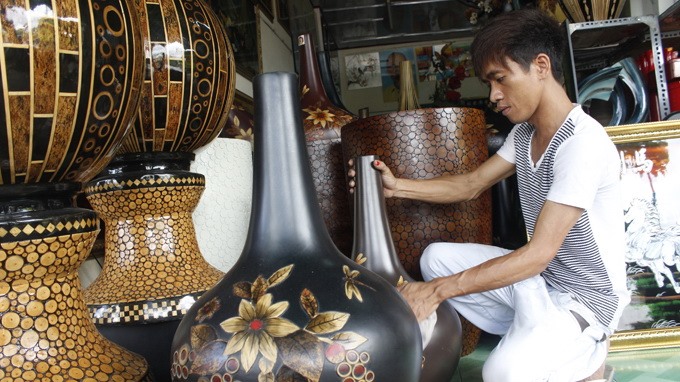 Society
Society

" />Visitors to Tương Bình Hiệp craft village in the southern province of Bình Dương’s Thủ Dầu Một City these days can have opportunities to witness the ebullient activities of artisans producing lacquerware works for the traditional Tết festival.
 |
| A man arranges lacquerware at a shop in Bình Dương Province. VNS File Photo. |
BÌNH DƯƠNG -- Visitors to Tương Bình Hiệp craft village in Thủ Dầu Một city in the southern province of Bình Dương can see a buzz of activity as artisans produce lacquerware for Tết in mid-February.
At the workshop of Tư Bốn Co. Ltd., 25 artisans are completing products like flower pots, vases, jars, and boxes, which would soon be delivered to some retailers.
Lê Bá Linh, director of lacquerware maker Tư Bốn Co., said sales had been good this year, a good sign for the development of traditional craft villages in Bình Dương, which have improved their quality and brands.
Trương Quan Tịnh, the head of Định Hoà Lacquerware Co., said there are two categories of lacquerware in the local market, traditional and modern.
He said Tương Bình Hiệp villagers have preserved their production process, which involves covering their products with 12 to 15 coats of traditional paints.
According “Bình Dương – A New Power of the 21st Century” published by the National Politics Publishers in 2003, immigrants from the north, including lacquerware artisans, travelled along the Sài Gòn River and settled in Thủ Dầu Một in the early 18th century.
They passed on their traditional lacquerware craft to locals, who have preserved it since.
In 1901 the French rulers in Việt Nam set up a vocational school in Thủ Dầu Một (now the Bình Dương Fine Arts and Culture School) to teach carving and lacquerware.
The Bình Dương traditional lacquerware craft was best promoted in the period 1945 – 1975 with the establishment of Tương Bình Hiệp Lacquerware by artisan Trương Văn Thành and the Thành Lễ lacquerware workshop by artisan Nguyễn Văn Lễ.
The two brought together many outstanding artisans, which gave a boost to the lacquerware craft and enabled exports to many European markets.
In addition to lacquerware paintings, in recent years lacquer has also been painted on decorative items such as vases, dishes, and bracelets.
According to figures released by the Bình Dương Statistics Bureau, in 2001 Tương Bình Hiệp village had 1,840 families with 3,860 lacquerware artisans.
The figures are now down to 90 families and 1,896 artisans.
Most young people in the village do not want to take up the traditional craft but instead seek jobs in industrial parks around the province.
To preserve and promote the craft, relevant authorities should have plans to train young artisans who love traditional lacquerware, Linh of Tư Bốn Co. said.
Trương Quan Tịnh, who has 40 years’ experience in making lacquerware, said a shortage of human resources is now one of the biggest difficulties facing the industry since young people no longer want to do the job.
To support lacquerware villages, provincial authorities have launched a tourism project in co-ordination with them, and seek to build brand names for them.VNS




